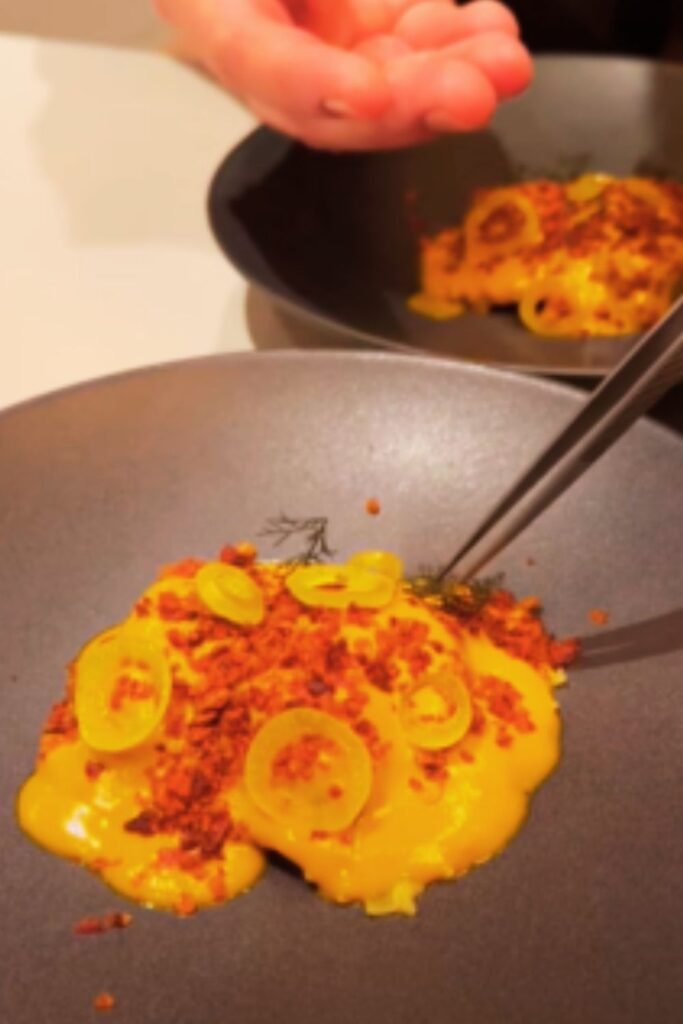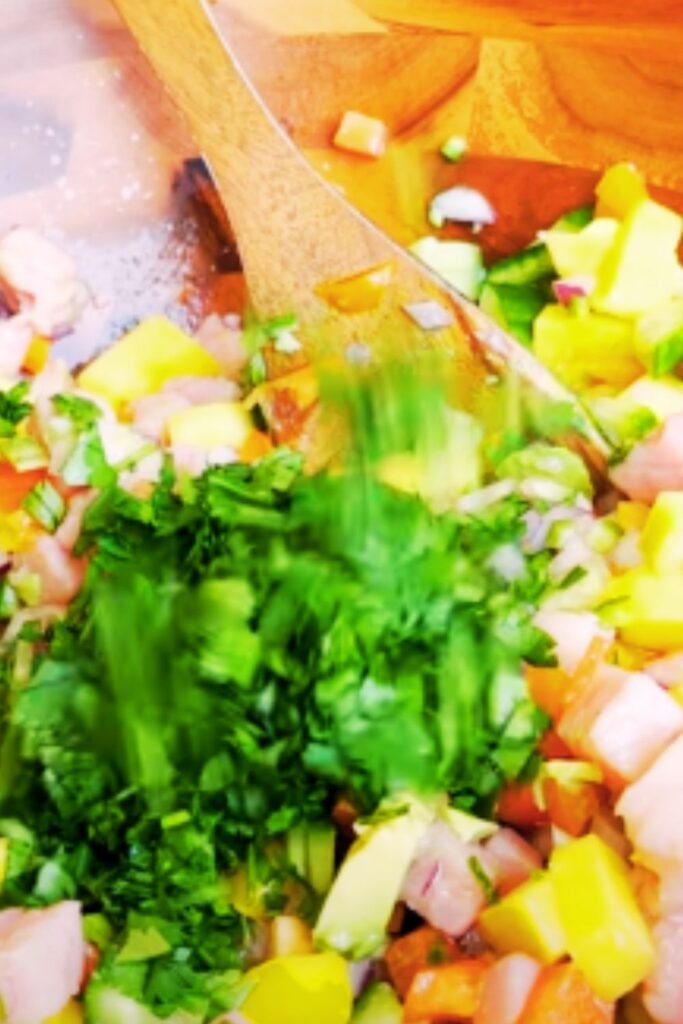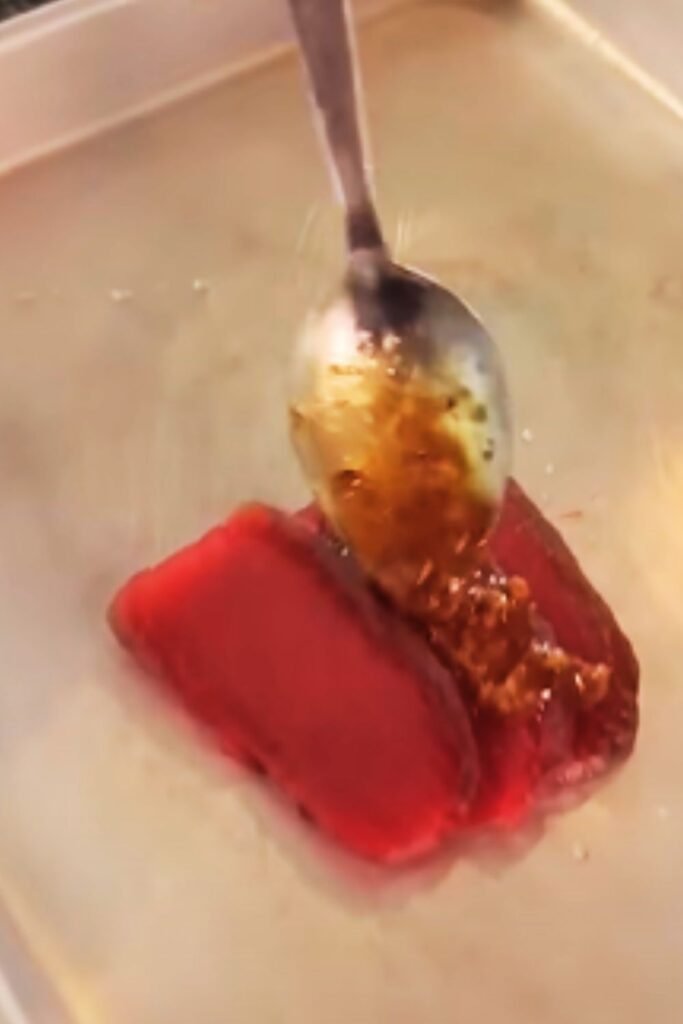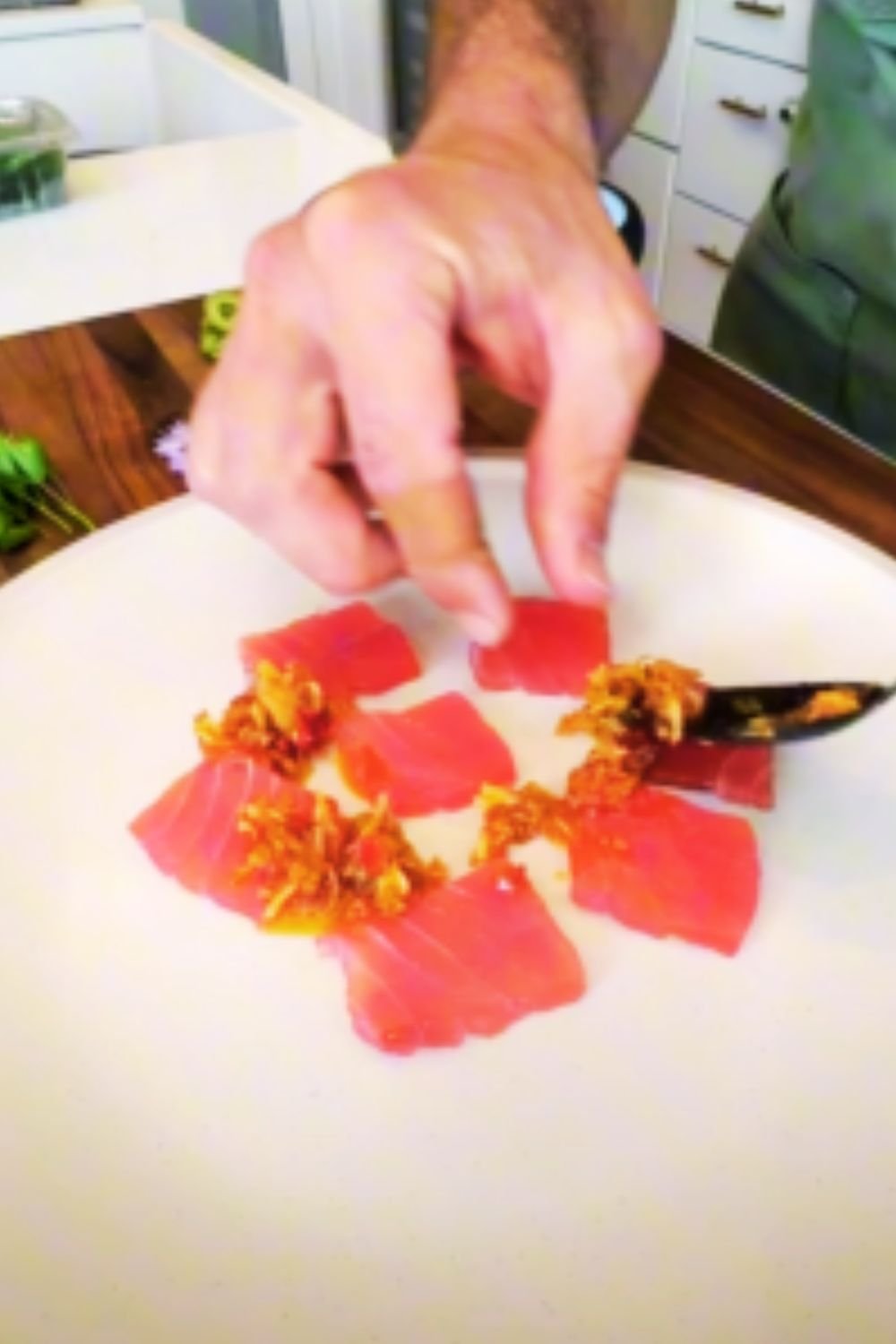There’s something magical about the first bite of a perfectly prepared crudo. The way the clean, pure flavor of fresh fish mingles with bright citrus and a touch of heat creates a symphony of taste that transports me straight to the sun-drenched shores of the Mediterranean. Today, I’m excited to share my recipe for Orange Calabrian Chili Tuna Crudo – a dish that brings together the succulence of sashimi-grade tuna, the vibrant sweetness of oranges, and the distinctive spicy kick of Calabrian chilies.
When I first discovered crudo (the Italian cousin to Japanese sashimi), I was immediately captivated by its elegant simplicity. Over the years, I’ve experimented with countless variations, but this orange and Calabrian chili combination has become my signature version that guests always request when they visit. The orange provides a perfect sweet counterpoint to the rich tuna, while the Calabrian chilies add that distinctive spicy depth that makes each bite unforgettable.
What Makes This Crudo Special
Before we dive into the recipe, let’s talk about what sets this dish apart. The marriage of sweet orange, spicy Calabrian chili, and buttery tuna creates a perfect balance of flavors that’s both sophisticated and accessible. It’s an impressive appetizer that looks like you spent hours preparing it, but actually comes together in just minutes – perfect for entertaining or for elevating a weeknight dinner into something special.
The key to an exceptional crudo lies in three elements:
- Impeccably fresh fish: This is non-negotiable. We’ll talk more about how to select the perfect tuna below.
- Balance of flavors: The citrus, heat, salt, and richness need to harmonize without any single element overwhelming the others.
- Proper technique: Slicing the fish correctly makes all the difference in texture and mouthfeel.
Ingredients: The Foundation of Excellence
For the Crudo:
- 12 oz sashimi-grade tuna loin (center cut preferred)
- 2 oranges (blood oranges when in season create a stunning presentation)
- 2-3 teaspoons Calabrian chili paste (adjust according to your heat preference)
- 1/4 cup extra virgin olive oil (the highest quality you can find)
- Flaky sea salt (Maldon works beautifully here)
- Freshly ground black pepper
- 1 shallot, minced finely
- 2 tablespoons fresh mint leaves, thinly sliced
- 1 tablespoon fresh chives, finely chopped
For the Citrus Marinade:
- Juice of 1 orange
- Juice of 1 lemon
- 1 tablespoon champagne vinegar
- 1 teaspoon honey
- 1/4 teaspoon kosher salt
Equipment You’ll Need
- Sharp chef’s knife or sashimi knife
- Citrus juicer
- Mixing bowls
- Serving platter (chilled)
- Microplane or zester
- Small whisk
Selecting the Perfect Tuna

The foundation of any great crudo is exceptional fish. Here’s what I look for when selecting tuna for this dish:
- Always sashimi or sushi-grade: This designation means the fish has been frozen according to FDA guidelines to kill potential parasites and is safe to eat raw.
- Appearance: Look for deep red flesh with minimal brown edges. The color should be vibrant and consistent throughout.
- Texture: The flesh should be firm with a slight give when pressed gently—never mushy or soft.
- Smell: Fresh tuna should have virtually no odor at all. Any fishy smell is a warning sign.
- Source: Purchase from a reputable fishmonger who can tell you when and where the fish was caught and how it’s been handled.
If you’re uncertain about the quality or freshness of your tuna, ask your fishmonger for guidance. They can help you select the perfect piece for your crudo.
Preparation: The Art of Crudo
Step 1: Prepare the Fish
- Remove the tuna from refrigeration about 15 minutes before slicing to take the chill off. This will enhance the flavor and texture.
- Using a sharp knife, slice the tuna against the grain into thin pieces, approximately 1/8-inch thick. The exact thickness is a matter of preference, but I find this thickness allows the fish to maintain its integrity while still being delicate.
- Arrange the slices on a chilled serving platter, slightly overlapping them for visual appeal.
Step 2: Create the Citrus Marinade
- In a small bowl, combine the orange juice, lemon juice, champagne vinegar, honey, and kosher salt.
- Whisk until the honey is fully incorporated and the mixture is unified.
- Set aside to allow the flavors to meld while you prepare the remaining ingredients.
Step 3: Prepare the Oranges
- Using a sharp knife, cut off the top and bottom of each orange to create flat surfaces.
- Following the contour of the fruit, cut away the peel and white pith.
- Working over a bowl to catch the juices, cut between the membranes to release the orange segments (supremes).
- Reserve the segments and any accumulated juice.
Step 4: Assemble the Crudo
- Lightly brush the tuna slices with the citrus marinade.
- Dot small amounts of Calabrian chili paste across the tuna slices. Remember, a little goes a long way!
- Drizzle the high-quality olive oil over the fish.
- Arrange the orange segments among the tuna slices.
- Sprinkle with the minced shallot, mint, and chives.
- Finish with a generous sprinkling of flaky sea salt and a few turns of freshly ground black pepper.
Step 5: Final Touch
- Allow the dish to rest for 3-5 minutes before serving to let the flavors meld.
- Serve immediately while all components are at their peak of freshness.
Serving Suggestions

This Orange Calabrian Chili Tuna Crudo works beautifully as:
- An elegant appetizer: Serve small portions on chilled plates with thin slices of toasted baguette.
- Part of a seafood antipasti spread: Pair with marinated olives, roasted peppers, and burrata.
- A light main course: Increase the portion size and serve with a small fennel salad dressed simply with lemon and olive oil.
To complement the dish, consider serving:
- Sparkling water with a twist of orange
- An iced tea infused with orange and mint
- A crisp citrus-forward mocktail
Regional Variations: The Versatility of Crudo
While my Orange Calabrian Chili version has become my signature preparation, crudo is wonderfully adaptable. Here are some regional Italian variations that might inspire your own creations:
| Region | Typical Flavor Profile | Common Ingredients |
|---|---|---|
| Sicily | Citrus-forward, often with pistachios | Blood oranges, pistachios, mint, olive oil |
| Amalfi Coast | Lemon-centric with herbs | Amalfi lemons, parsley, capers, olive oil |
| Puglia | Bold with fennel and citrus | Fennel, orange, black olives, olive oil |
| Liguria | Delicate with pine nuts and basil | Basil, pine nuts, lemon, olive oil |
| Calabria | Spicy and bold | Calabrian chilies, orange, olive oil |
The Perfect Pairings: Balance and Contrast
Creating a memorable dining experience is about more than just the main dish. Here are some perfect accompaniments for your tuna crudo:
| Pairing Type | Suggestion | Why It Works |
|---|---|---|
| Bread | Thinly sliced, toasted baguette | Provides textural contrast without overwhelming the delicate fish |
| Salad | Shaved fennel with lemon and olive oil | The anise notes complement the citrus and fish beautifully |
| Vegetable | Grilled asparagus with lemon zest | The charred flavor balances the freshness of the crudo |
| Starch | Crispy polenta squares | Offers a warm, crispy contrast to the cool, soft fish |
| Garnish | Micro greens or edible flowers | Adds visual appeal and subtle flavor notes |
Nutritional Benefits: The Healthful Side of Crudo
One of the reasons I love serving crudo is not just its incredible flavor but also its nutritional benefits. Here’s what makes this dish a nutritional powerhouse:
| Ingredient | Key Nutrients | Health Benefits |
|---|---|---|
| Fresh Tuna | Omega-3 fatty acids, high-quality protein, selenium, vitamin B12 | Supports heart health, brain function, and immune system |
| Oranges | Vitamin C, flavonoids, fiber | Antioxidant properties, immune support, digestive health |
| Olive Oil | Monounsaturated fats, vitamin E, polyphenols | Anti-inflammatory properties, heart health, antioxidant effects |
| Calabrian Chilies | Capsaicin, vitamins A and C | May boost metabolism, anti-inflammatory properties |
| Fresh Herbs | Various phytonutrients | Antioxidant properties, flavor enhancement without added sodium |
Troubleshooting: Common Crudo Challenges
Even experienced cooks sometimes encounter challenges when preparing raw fish dishes. Here are solutions to common issues:
| Challenge | Solution |
|---|---|
| Fish tastes too “fishy” | Your tuna wasn’t fresh enough. Always use the freshest fish possible and consume it the same day you purchase it. |
| Too much citrus overwhelms the fish | Balance with a touch more olive oil or honey in the marinade to counteract acidity. |
| Chili heat is too intense | Dilute the Calabrian chili paste with a bit more olive oil before applying, or serve with additional orange segments. |
| Tuna slices are uneven | Chill the fish thoroughly before slicing and ensure your knife is extremely sharp. Practice makes perfect! |
| Texture is too chewy | Your slices may be too thick. Aim for translucent, thin slices for the best mouthfeel. |
Seasonal Adaptations: Year-Round Enjoyment
While this recipe is perfect as written, you can adapt it throughout the year to highlight the best seasonal ingredients:
| Season | Adaptation |
|---|---|
| Winter | Use blood oranges and add a sprinkle of toasted pine nuts |
| Spring | Incorporate fresh pea shoots and edible flowers as garnish |
| Summer | Add diced ripe peach or nectarine alongside the orange |
| Fall | Include pomegranate seeds for color and flavor contrast |
The History of Crudo: A Brief Culinary Journey
Crudo has ancient roots in Italian coastal cuisine, particularly in regions where the fishing industry thrived. Unlike Japanese sashimi, which focuses on the purity of the fish with minimal seasoning, Italian crudo traditionally incorporates olive oil, citrus, and local herbs.
The dish began as a practical way for fishermen to enjoy the freshest catch directly on their boats. Over time, it evolved into a sophisticated appetizer found in the finest restaurants along the Italian coastline. Today, innovative chefs worldwide are putting their own spin on this classic preparation, but the fundamental principles remain: exceptional fish, high-quality olive oil, and a perfect balance of complementary flavors.
My Personal Touch: Calabrian Chilies

Calabrian chilies are the secret weapon in this recipe. Native to the Calabria region of southern Italy, these vibrant red peppers pack a distinctive heat that’s spicy without being overwhelming, with wonderful fruity undertones that complement the orange perfectly.
I first discovered these chilies during a culinary tour of southern Italy, where a local chef used them in a simple crudo that changed my perspective on raw fish preparations. The heat builds gradually, enhancing rather than masking the flavor of the tuna.
If you can’t find Calabrian chili paste, you can substitute with a mixture of crushed red pepper flakes and a touch of roasted red pepper, though the flavor profile will be slightly different.
Q&A: Your Tuna Crudo Questions Answered
Q: Can I prepare any components of this dish ahead of time?
While crudo is best prepared just before serving, you can prepare the citrus marinade up to 24 hours in advance and keep it refrigerated. You can also supreme the oranges a few hours ahead and keep them covered in the refrigerator. The tuna should always be sliced immediately before serving for the best texture and flavor.
Q: I can’t find sashimi-grade tuna. Are there any substitutes?
Safety first – never use non-sashimi-grade fish for raw preparations. If you can’t find sashimi-grade tuna, you could substitute with another sashimi-grade fish like salmon or hamachi (yellowtail). The flavor profile will be different, but still delicious. Alternatively, you could adapt this recipe to use quickly seared tuna instead of raw.
Q: How spicy is this dish? Can I make it milder?
The spice level is entirely customizable. Calabrian chili paste varies in intensity depending on the brand, so start with a small amount and adjust according to your preference. For a milder version, you can dilute the chili paste with additional olive oil or use roasted red peppers with just a pinch of red pepper flakes instead.
Q: What’s the difference between crudo and ceviche?
While both dishes feature raw fish, ceviche involves “cooking” the fish in citrus juice (typically lime) for a period of time, which changes its texture and appearance. Crudo, on the other hand, is dressed with oil and seasonings just before serving, leaving the fish in its natural raw state.
Q: How long can I keep leftover tuna crudo?
Honestly, crudo doesn’t make good leftovers. Once the fish has been sliced and dressed, it should be consumed within an hour for optimal flavor and texture. I always recommend preparing only what will be eaten immediately.
Q: Can I use regular oranges instead of blood oranges?
Absolutely! While blood oranges add dramatic color and a slightly more complex flavor when in season, regular navel or Cara Cara oranges work beautifully in this recipe. Each variety will bring its own subtle flavor nuances to the dish.
Q: Is this dish keto-friendly?
This crudo is naturally low in carbohydrates, making it suitable for those following a ketogenic diet. The small amount of honey in the marinade adds minimal carbs per serving, but you could omit it or substitute with a keto-friendly sweetener if preferred.
Q: What’s the best way to slice tuna for crudo?
For the best texture, slice the tuna against the grain in thin, even slices. Chilling the tuna for about 15 minutes in the freezer before slicing can make it easier to achieve clean, precise cuts. A very sharp knife is essential – if possible, use a dedicated sashimi knife or a well-sharpened chef’s knife.
Final Thoughts: The Joy of Crudo
There’s something profoundly satisfying about preparing a dish that celebrates the pure, clean flavors of exceptional ingredients. This Orange Calabrian Chili Tuna Crudo does exactly that – it honors the fish while enhancing it with complementary flavors that elevate rather than mask its natural beauty.
I hope this recipe inspires you to explore the world of raw fish preparations with confidence and creativity. Whether you’re serving it as an impressive starter for guests or as a special treat for yourself, this crudo is a reminder that sometimes the simplest preparations yield the most extraordinary results.
Remember, the quality of your ingredients is paramount here. Seek out the freshest fish, the best olive oil, and the ripest citrus you can find. Your palate will thank you for it.
Buon appetito!

